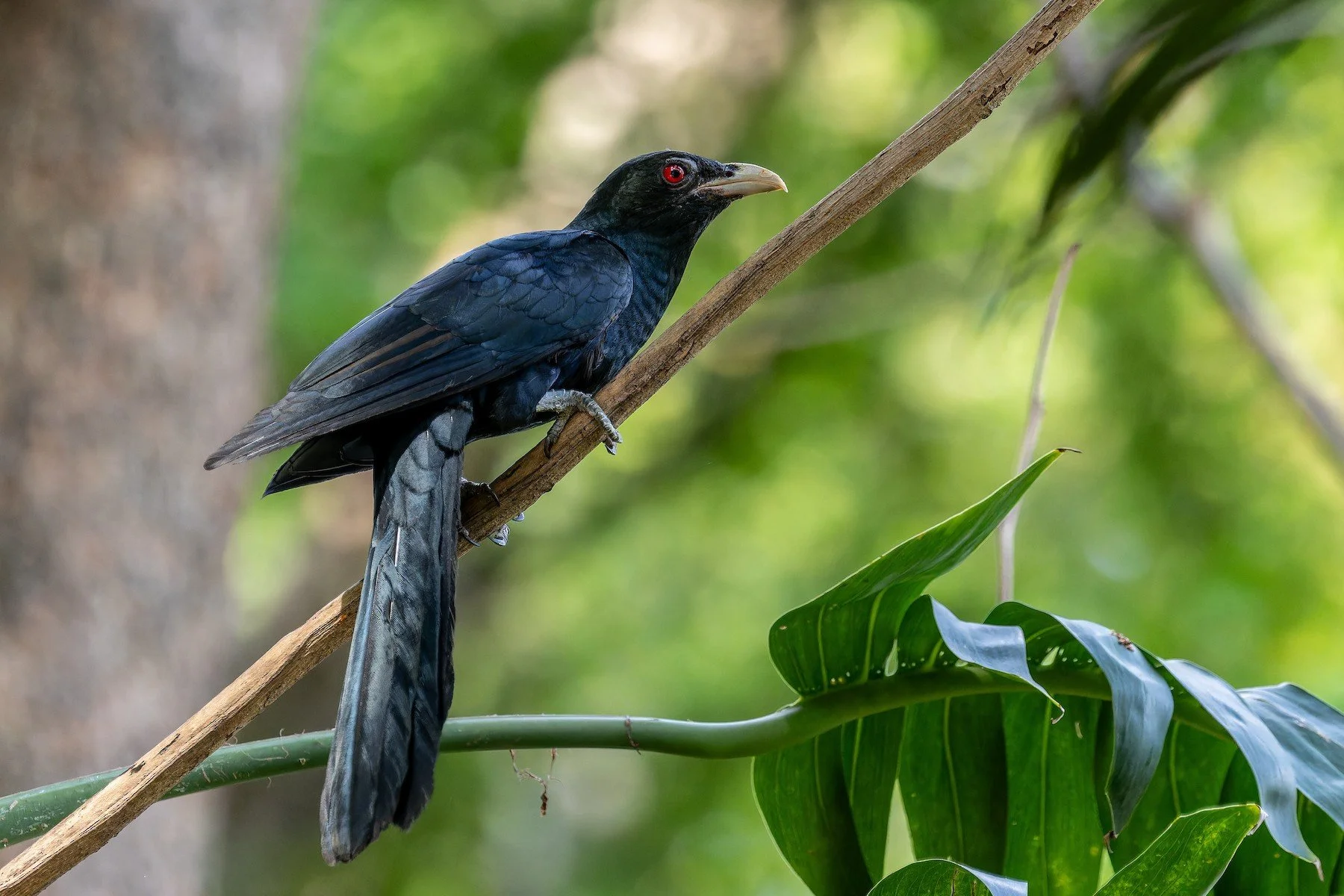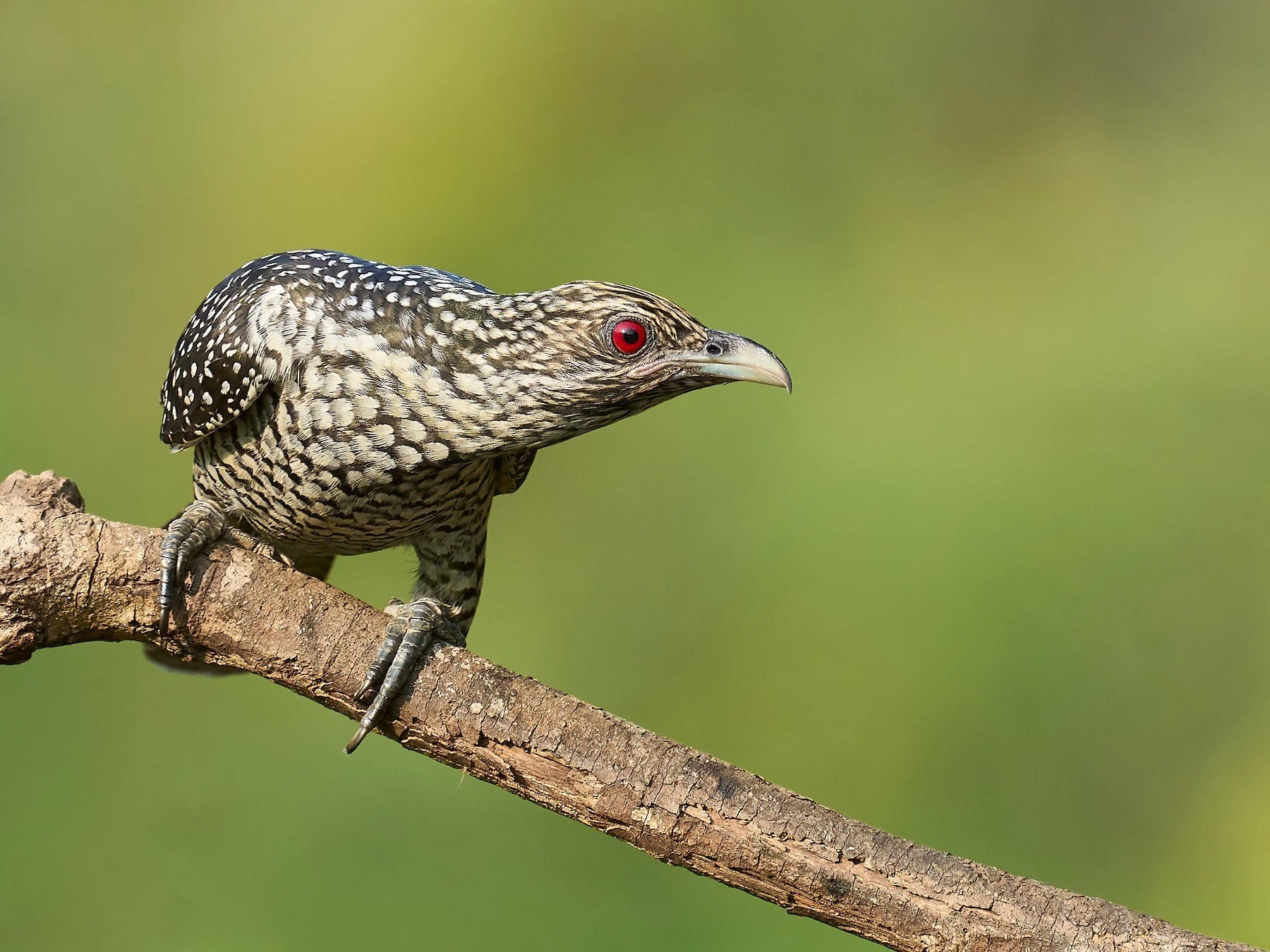Asian Koel
Eudynamys scolopaceus
The Asian koel is a brood parasite that lays its eggs in the nests of other birds. The species is also sexually dimorphic: males are dark-feathered goths, while females are boldly streaked in brown and white.
The Goth & the Stormbird
If any bird could serve as a gothic muse, it would surely be the Asian koel. Ravens look mild compared to this disturbing ave. The hunched figure of a male koel is shrouded in black plumage. Clawed, grey-scaled feet clutch at its perching branch. Its tail feathers, especially when outspread, are often tattered-looking, like a torn-up tapestry. The tip of its ivory beak is a sharp hook, curving into a glowering scowl. And above its scowl are eyes of crimson-red.
It's a fancifully gothic portrait: feathers all black, a grimacing bill, and blood-red eyes. But this Poe-esque bird is only half the picture. The female, in contrast to the male's dour appearance, is a fierce stormbird — like a lightning strike in avian form. All of her feathers are striped, streaked or speckled. White spots adorn her brown wings and back. Dark smears run across her light neck and breast, becoming a volley of arrows that shoot down her belly. Her brown tail is slashed with white bands, like serrated daggers, against a bright sky. Unlike the male's slicked-back crown, the female often sports a prickly feather mane. As with many sexually dimorphic birds, the female appears like a completely different species. But she's betrayed by her eyes: striking red, like the male's.
It isn't the nightmarish male koel, however, that is most feared. It is the ruthless female, for the Asian koel is a brood parasite, a member of the infamous cuckoo order.
Con Artists & Changeling Chicks
In nature, there are few tactics sneakier than tricking someone else into raising your children. That's what a brood parasite does: it offloads the burden of protection and feeding onto another unwitting couple.
In a partnership both romantic and macabre — a feathered Bonnie and Clyde — an Asian koel couple work in tandem to pull off their reverse heists. The male scouts out host nests, crying out — “ko-eeul” — to alert his partner when he's found one. If the host parents are nearby, the male plays the role of distraction. While the parents are busy fussing about the black-clad intruder, the female homes in on the nest, alights on the rim and lays a single, alien egg into the host's clutch. Sometimes, to prevent suspicion from an overcrowded nest, she discards one of the host's actual eggs. Pale-grey and speckled, her egg closely resembles that of a crow — and not by coincidence, since crows are often the Asian koel's victims.¹ She then takes to the wing, leaving her egg in the care of the host, her duty as a parent finished.
From the egg emerges a parasitic chick. It is an ugly, featherless thing, as all altricial chicks are, its bulging eyes still closed. Hatching some three days before the rest of its "siblings", the parasite is presented with a sinister opportunity: the koel hatchling can try to evict the host's eggs, sending them tumbling over the edge of the nest before they get a chance to hatch. Compared to other brood parasites, however, koel chicks are fairly benign.² The praise is faint. All it means is that koels are less likely to commit step-siblicide, perhaps because crow eggs are large and the nest is quite deep.
The parasitic chick then does everything in its power to mislead and manipulate its host parents. A young koel even adopts the calls of a crow, cawing and crying out to be fed, harrying its host parents to expend time and energy to feed its voracious appetite — so voracious that a few of its crow cohorts will sometimes starve. It soon outgrows the nest and moves to perch on a nearby branch; even so, it continues to beg its foster parents for more food. Eventually, when it's grown big and strong from the efforts of its "adoptive" parents, the young koel simply takes off at summer's end, following the other koels. It returns the following year as an adult to abandon its own eggs in the nests of strangers. One has to wonder if our folkloric changelings were inspired by such brood parasitism.³
Koel, Koili, Kokila
Arriving in southern Asia — in India and Nepal — the Asian koel heralds the coming of spring, of warmer weather, and the pre-monsoon rains. For Nepali farmers, this is the time to sow their fields with rice and millet, and they know it's time to sow when they hear the echoing "koo-Ooo" calls of koels. There, this koel is known as the koili, another onomatopoeic interpretation of its call, while in Sanskrit it's known as the kokila and features in many stories, myths, and poems: sometimes representing birth and the renewal of spring, with images of koels cooing among blossoming mangoes, and sometimes the passions of love and fertility, with phrases like “mad as a koel” highlighting the intensity of koel courtship. Despite such romantic descriptions, the Asian koel was recognised for what it is long ago. In the Sanskrit Vedas, written in the 2nd millennium BCE, the koel was referred to as Anya-Vapa, which translates to "that which was raised by others" — the earliest recorded knowledge of brood parasitism.
¹ A study carried out in India found that 5% of house crow nests and 0.5% of large-billed crow nests were being parasitised. But the Asian koel doesn't only target crows. In southern Thailand and the Malay Peninsula, the koel has increasingly turned to parasitising the nests of mynas as they become more common. Across the Indian subcontinent, the Asian koel is also known to parasitize Eurasian magpies and black drongos.
² The first act a common cuckoo chick commits is murder. Soon after hatching, it hoists its host's eggs onto its back and dumps them over the edge.
³ In European folklore, a child might be taken by the fae and swapped out by an imposter child, a changeling. Just as the koel chick mimics the calls of its host species, the changeling was said to mimic the human child, though always with some imperfection.
Where Does It Live?
⛰️ Open woodlands and urban parks.
📍 Indian Subcontinent through eastern China, and across Southeast Asia.
‘Least Concerned’ as of 01 Oct, 2016.
-
Size // Small
Length // 39 - 46 cm (15 - 18 in)
Weight // 190 - 327 g (6.7 - 11.5 oz)
-
Activity: Diurnal ☀️
Lifestyle: Pair 👥
Lifespan: 12 - 14 years
Diet: Omnivore (primarily frugivorous)
Favorite Food: Fruits 🍈
-
Class: Aves
Order: Cuculiformes
Family: Cuculidae
Genus: Eudynamys
Species: E. scolopaceus
-
Asian koels make for mismatched couples. The males are black-clad goths, while the females look like fierce thunderbirds, streaked and speckled in brown and white. Sexually dimorphic, they nonetheless share startling, blood-red eyes.
But while the male looks macabre, it’s the female who’s feared, for the Asian koel is a brood parasite.
The male is simply a partner in crime: he seeks out the nest of another bird species (often a crow) and calls ("koo-Ooo") to his Bonnie — if the owners of the nest are present, it is also his job to distract them.
The female then flies in, perches on the rim, and dumps an egg into the host's nest (sometimes removing one of their eggs too).
Then the couple flies off, their parental duties done.
The koel chick hatches before its "siblings" and will sometimes try to push their eggs from the nest — although it's often unsuccessful as crow nests are quite deep.
The parasitic chick then ceaselessly begs its host parents for food. The parents, tricked into thinking that this is their hungry chick, slavingly oblige. Even when the koel grows too big for its nest, it perches on a nearby branch and continues demanding food.
Then, come summer's end, the koel simply takes off and follows the other koels.
-
Cornell Lab: Birds of the World
BBC Earth News - Cuckoo in egg pattern 'arms race'
-
Cover Photo (© sunnyjosef / iNaturalist)
Text Photo #01 (© Sila Viriyautsahakul / Macaulay Library)
Text Photo #02 (© Fareed Mohmed / Macaulay Library)
Text Photo #03 (© Saswat Mishra / Macaulay Library)
Text Photo #04 (Tamil and Vedas)
Text Photo #05 (© Kelvin Joshua Che / iNaturalist)
Slide Photo #01 (My own photo, taken in Bangkok, Thailand)
Slide Photo #02 (© Raghavendra Pai / Macaulay Library)
Slide Photo #03 (My own photo, taken in Koh Samet, Thailand)













